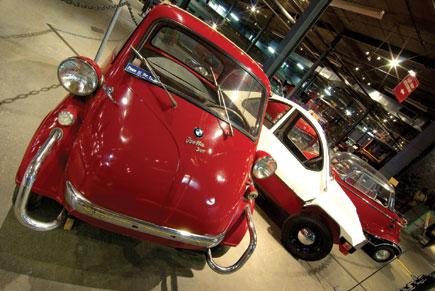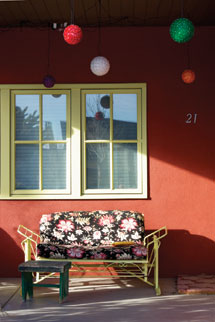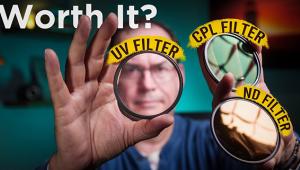The Pentax K10D; The Digital K-Mount World Expands Page 2
In Camera Processing
The Pentax K10D series permits in camera monochrome and image manipulation but
not at time of capture. The Digital Filter found in the Playback menu offers
Black & White, Sepia, Slim, Soft, Brightness, and Color effects. Only JPEGs
need apply; raw images cannot be processed using Digital Filter.
The Black & White filter does what you think it will, and rotating the e-dial
wheel lets you apply red, green, and blue digital filters. The Sepia filter
applies three different intensities of "sepianess" by turning the
e-dial and the Soft filter lets you add a soft focus effect by selecting one
of three levels. If your original photograph is a little dark or too bright,
the Brightness filter lets you apply eight levels of (plus or minus) brightness
to a photograph. The Slim filter changes the image's horizontal and vertical
aspect ratio, adjusting the photograph's height or width up to two times
the original size. Why? My guess is that this is for home market consumption,
just not our home.
The upside of using this process is that when a filter is applied, your color
original remains untouched. These kinds of effects can be applied in the digital
darkroom but doing it in camera lets you make prints with the effects directly
from a kiosk without having to load the files onto a computer. I would prefer
that monochrome images be captured directly and appreciate Pentax's logic,
but found it inconvenient to capture then convert a file.
 |
 |
||
|
|
Shooting The K10D
Pentax claims that the K10D has a multiplication factor of "approximately"
1.5, although I have seen some wags on the web claim it is closer to 1.6 or
1.7 so I will leave it to the mathematicians in the audience to crunch the numbers.
Out here in the real world it means that longer lenses appear longer (although
capturing the same angle of view, just less of it) but more importantly wide
angle lenses are longer, too. Pentax makes two wonderfully versatile and sharp
lenses for their D-SLRs, including the smc P-DA Fish-Eye 10-17mm f/3.5-4.5 and
smc P-DA 12-24mm f/4.0.
Whether you shoot raw, DNG, or JPEG, the images the Pentax K10D produces are
impressive. The camera is well designed and all the switchgear is made to professional
standard. Instead of a flimsy rubber cover over its input/output ports there's
a solid door that opens and closes like it should instead of flopping in the
breeze. The camera's ergonomics are wonderful, whether you shoot with
the battery grip on or off. Unlike other battery packs that require you to remove
the battery door to attach it, the D-BG2 lets you keep the camera body battery
inside, giving you access/back up to two batteries, although only one is in
the grip. Get a spare ($49.95), so you can use this feature. Under normal conditions
a single battery allows 500 shots per charge and it never let me down, although
extensive use of the built-in flash slowed the ability to make rapid sequence
flash shots while waiting for the flash to recycle.
 |
 |
||
|
|
With the proper filter, such as Singh-Ray's (www.singh-ray.com)
I-Ray Infrared, I was able to capture near infrared images with the Pentax K100D.
The K10D appears to use a different imager or must have a built-in IR filter,
because the on-chip infrared response with the I-Ray produced a weak effect,
no matter the exposure. So digital IR fans, you're out of luck with the
K10D.
I don't bracket with digital as much as I did with film but sometimes
it's just prudent to do so. The K10D makes it easy by providing a bracket
button that (for right-eyed shooters) falls under your left thumb. Pressing
the button gives you three settings, including off, a three-shot bracket, and
a five-shot bracket. After choosing Bracket mode, pressing and holding the shutter
release fires all three or five shots in sequence. You can also change the order
of exposures with the Custom Function, but I always use the traditional underexposed
to overexposed progression.
 |
|
|
Like the bracket button, the K10D is festooned with lots of manual control
levers, knobs, and buttons, my favorite being the bracket button and my unfavorite
being the twist-lock for opening the memory card door. The *ist D models had
a similarly horrible feature that thankfully disappeared on the K100D, but now
it's back on the K10D, adding what some designer must have thought was
a touch of pro panache to a camera that doesn't need it--the rest
of the camera already says that. There is a similar twist-lock camera battery
door on both the bottom of the camera and the D-BG2, but in these cases it's
a really good idea. Nobody wants the battery to fall out.
The Pentax K10D has the look and feel as well as performance of a much more
expensive camera. The optional D-BG2 Battery Grip costs $190 and when you purchase
the camera be sure to get one. It's indispensable. The K10D body costs
$899.95 or as a kit with the redoubtable DA 18-55mm lens $999.95. I know a bargain
when I see one.
 |
|
|
Firmware Update
As we were going to press, Pentax announced a firmware upgrade. Highlights of
Version 1.10 include the ability to let the built-in flash wirelessly control
external Pentax flashes. In Autofocus Select mode, you can program the AF button
to return to the center autofocus point. In Tv or Av mode, you can program the
second e-dial to adjust the ISO setting, which is a great idea. In any Exposure
mode (except Sv and TAv) you can change the ISO setting with the front e-dial
while pressing the OK button. There are a few more tweaks and the updates may
be more significant to some users than others, but applying the update is easy.
Download the file, copy it to a SD card, stick the card in the camera while
pressing the menu button, and "Bob's your uncle."
Technical Specifications
Dimensions: 5.6x4.0x2.8"
Weight: 25.0 oz
Price: $899.95 (body)
Website: www.pentaximaging.com
For more information, contact Pentax Imaging Company, 600 12th St., Ste. 300, Golden, CO 80401; (800) 877-0155; www.pentaximaging.com.
- Log in or register to post comments

































